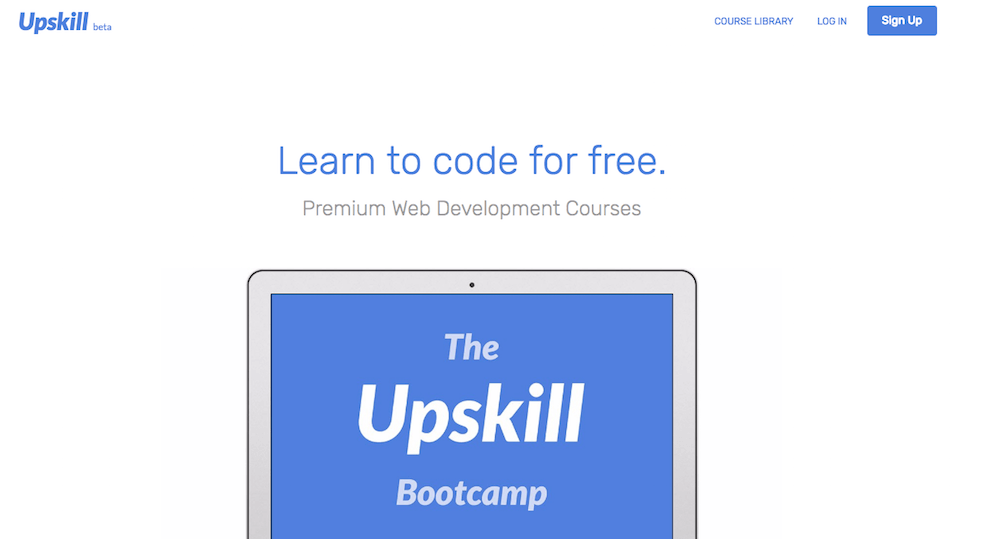If you’re brand new to the world of coding and web development, it makes sense to start by teaching yourself using all the free coding resources online.
By taking advantage of these resources as you learn to code for free, you can discover what you like and don’t like before investing money into a certain coding language or set of courses. Once you’ve gone through enough free coding lessons to find that direction, you’ll be able to channel your passion to continue learning coding online most efficiently.
However, there are so many free coding resources and classes and books to choose from. How do you know which are the best places to learn coding online?
Well, I did some research to save you the time! Here are some of the best websites to learn coding for free–from simple coding tutorials to full free online coding courses.
Please note: all information, topics taught, etc., have been taken at time of updating and are definitely subject to change. Thanks!
Classpert is a search engine that helps you find and compare online courses in computer science, data science, business, and more. With over 140,000 free and paid courses from more than 30 course providers, you’ll be spoilt for choice. You can even watch course previews and compare syllabuses side-by-side to find the best course for you..
GENERAL
1. Codecademy
Codecademy is where most people who are new to coding get their start learning programming online, and its reputation is well-deserved. The platform revolves around interactive learning; that is, you read a little, type your code right into the browser, and see results immediately.
What free coding lessons they offer: HTML & CSS, JavaScript, PHP, Python, Ruby, Angularjs, The Command Line, and more
2. freeCodeCamp
This free online coding school teaches coding first through an established curriculum (approx. 800 hours total), then by giving you hands-on experience working on projects for nonprofits. It’s perfect for learners who want to learn code online by getting practical, hands-on experience that will do some good and look impressive on a resume.
Free coding certifications on offer: HTML, CSS, JavaScript, data visualization, DevTools, QA testing, Node.js, React, jQuery, and more
3. Coursera
Coursera is one of the best places to learn to code for free, with its professional and versatile course options. The site is a large online course library where classes are taught by real university professors. All courses are free of charge, but you have the option to pay for a “Coursera Verified Certificate” (prices range between $30-$100) to prove course completion. Sometimes paying for a certificate also grants access to content not available in the free versions. Coursera also offers “Specializations,” which are collections of courses on a specific topic, typically with a capstone project at the end.

What free coding courses they offer: Many (far beyond your basic coding/computer science topics)
4. edX
EdX is an open-source higher education program governed by MIT and Harvard, making it another high-caliber resource where you can learn to code for free online. The site offers 107 great courses under the “computer science” category, teaching various coding languages.
Free programming courses offered: Java, C#, Python, and many more
5. Codewars
Codewars offers a fun and unique way to learn coding. With a martial-arts theme, the program is based on challenges called “kata.” Complete them to earn honor and progress to higher ranks. This is a fun way to learn programming online if you’re motivated by a little gamification!
Coding challenges they offer: CoffeeScript, JavaScript, Python, Ruby, Java, Clojure, and Haskell
6. GA Dash.
This is General Assembly’s free online learning platform. It’s entirely project-based–you build a “project” with each walkthrough–making it ideal for those who like to get hands-on while learning to code online.
They are one of the very few free coding resources that have a course on how to build a Tumblr theme from scratch. Read my review of it here.

What free coding projects they offer: HTML, CSS, JavaScript, responsive design
7. Khan Academy
Khan Academy offers tons of subjects (as their front page says, “You can learn anything”), including many on computer programming. A few courses are offered for younger kids, too–so the whole family can learn to code for free!
Coding resources they offer: JS, HTML/CSS, SQL, much more
Competition to get into MIT may be stiff, but accessing their course material online has no tuition or minimum SAT score. They maintain an online library of every subject they teach, with no account required for access; just browse for a course and start reviewing the material. Yep…you can learn programming for free at MIT. What a world.
The Massachusetts Institute of Technology OpenCourseWare

The Massachusetts Institute of Technology (MIT) OpenCourseWare (OCW) is a great initiative undertaken by MIT. As part of this platform, all the study materials of the MIT undergraduate and graduate-level courses are brought online so that you can study them at anytime and anywhere with free access to all.
Apart from the other subjects offered, this platform offers free online courses related to computer science.
Some of the introductory programming courses include online learning for Java, Python, C and C++, and MATLAB programming. You can browse through these free courses to search for one that meet your requirements.
Modern-day warriors can set sail for learning to code with the Odin Project. It’s made by the creators of Viking Code School—a premier online coding bootcamp—and the Odin Project is their free, open-source version. While you learn to code for free with their programming tutorials, you can check in for support from other students using the online chat group!
Topics available: HTML, CSS, JavaScript & jQuery, Ruby programming, Ruby on Rails
10. Udacity
Udacity offers individual free coding courses, as well as “nanodegrees” that train you for specific careers like front-end web developer or data analyst. Course materials are free, but nanodegrees require a tuition fee.

What free tech programs they offer: Many (not just coding)
11. SoloLearn
SoloLearn is a social platform where anyone can learn to code. It’s different than other course providers because it’s mobile-based: learn coding on the go, on any device. With bite-sized lessons, achievements to unlock and interactive quizzes, it makes learning to code fun, and it’s free to download.
Coding lessons they offer: Many
12. The Code Player
A compilation of video-based online coding tutorials to help you walk through a process from start to finish. Good for learning code online with “smaller” projects/tasks one at a time.
Free coding tutorials available: HTML5, CSS3, Javascript, Regex, JQuery
13. Bento.io
Their mission is to inspire people to become programmers by making code accessible, affordable, and fun. Given that they offer over 200 topics, anything you’ve been thinking about learning, you can find here.

Web development tracks to choose from: Many
14. Udemy
They offer both paid and free courses. Note that on Udemy, courses can be created by anyone, so make sure to read reviews. Coupons can also be easily found, too, and sales are frequent. Check out their development courses here.
Free coding courses they offer: Many
15. Code.org
Code.org provides learning materials specifically dedicated to increasing the rates of female and minority students entering computer science careers. Their free coding courses are designed for K-12 students, but can be useful to all ages. Start out with their quick Hour of Code tutorials, or build projects in lab courses.
Coding courses offered: HTML, CSS, JavaScript, block programming
16. Scotch.io
This free coding website covers lots of topics related to web development and workflow. The platform features short courses, tutorials, guides, blog posts, and videos.
Free coding resources available: Angular, node.js, laravel, Sublime Text, and more.
17. Hackr.io
This isn’t a platform itself, but it’s a great list of community-curated programming resources. Simply search for the language you want to learn and you’ll get a list of the best online courses, tutorials, and books recommended by coders.

Free coding lessons they offer: None, but they recommend many
18. W3Schools
Perfect for beginners, W3Schools is the world’s largest web developer site, offering free coding tutorials and reference materials for learning just about every aspect of web programming. You can also test your skills with quizzes and complete coding exercises using their online editor.
What free coding tutorials they offer: HTML, CSS, JavaScript, SQL, PHP, jQuery, and more
19. Coderbyte
Learn to code by doing it! Coderbyte teaches you the basics of popular programming languages and lets you build up your new skills using their library of 200+ coding challenges and solutions.
Free coding coding challenges: JavaScript, Ruby, Python, HTML, CSS, Node.js, and more
Microsoft Virtual Academy’s Learning Paths are curated free coding courses designed to help you build valuable skills through video tutorials, demos, assessments, and more. You’ll also get access to free e-books, helpful downloads, and a community support forum.
Free learning paths available: MEAN stack, SQL, Azure, ASP.NET, HTML
21. Edabit
Edabit is “like Duolingo for learning to code,” offering bite-sized coding challenges that simulate what programming is like in the real world.

Topics their challenges cover: Java, JavaScript, PHP, Python, C#, C++, Ruby, Swift
22. Launch School Open Book Shelf
Written to supplement Launch School’s software engineering curriculum, these free books will help you learn the basic foundational building blocks of popular languages.
What free coding topics they cover: Git and GitHub, the Command Line, Ruby on Rails, SQL
23. Datacamp
Featuring free access to Python, SQL, Git, and much more. More than 100 classes, coding tutorials, practice challenges, data projects, and more.
24. QuickCode
QuickCode offers free trials for classes in a number of various programming languages. The most popular project on QuickCode is the opportunity to build a virtual voice assistant.
25. Learn Code The Hard Way
Python, Ruby, JavaScript, SQL and more. As of this writing, the Ruby course is the only one that is completely free, but each of the other lessons has some sizable free material that is worth checking out.
26. Free Code Camp
HTML, Git, JavaScript, databases, CSS and more. FreeCodeCamp is one of the biggest publications on Medium, and some of their YouTube videos have millions of views. When you learn with FreeCodeCamp it’s also a lot like Dash and Codecademy where you learn in the browser. And so, afterwards, you’ll want to learn how to use a text editor.
27. Code Avengers
Code Avengers offers Python, HTML, JavaScript and more. Code Avengers is a site which specializes in kids as well as adult learners, which makes it unique on this long list.
28. MySQLTutorial
A tutorial page for learning SQL that features screenshots. It offers a number of steps to get into SQL, and a helpful tool called MySQL TryIt.
Features basic interactive courses for a number of SQL topics including functions and queries. A helpful Course Advisor lets users know where to begin.
30. onemonth.com
Learn HTML for Free
Curious about coding? Want to learn to speak geek? Don’t be overwhelmed — this beginner course is the perfect introduction to web development with HTML, and CSS.
31. Intro to Programming: Chapter One
Skillshare
Deciding to learn a programming language can seem pretty daunting. That’s why this course is a good place to begin your journey—it’ll show you the basic concepts you need to know and give you that background knowledge so you can tackle coding with all your questions answered.
Length: 9 videos
32. How to Make Apps With No Programming Experience,
Skillshare
Have a great idea for an app, but don’t know how to turn it into a product? Here’s how you can start to make your own prototype today.
Length: 14 videos
33. AGupieWare
AGupieWare is an independent app developer that surveyed computer-science programs from some of the leading institutions in the U.S. It then created a similar curriculum based on the free courses offered by Stanford, MIT, Carnegie Mellon, Berkeley and Columbia. The program was then broken into 15 courses: three introductory classes, seven core classes and five electives.
While you won’t actually receive academic credit, this is a perfect introductory program for prospective computer programmers.
34. Hack.pledge()
This is a community of developers, which include some high-profile developers such as Bram Cohen, the inventor of BitTorrent. Here, you can perfect your programming skills by learning from some of the leading developers in the world.
35. BitDegree

BitDegree offers a ton of free courses that range from programming to game development.
They offer standard online courses and gamified courses. Gamified courses help to bring achievement and interaction into the learning process. All you have to do is choose your language and start learning.
There are a variety of programming languages covered, but the most popular ones are highlighted below:
- HTML
- CSS
- PHP
- Javascript
- SQL
- JQuery
BitDegree also does something unique by incorporating blockchain into the education process. There are transparent rewards and an achievement system that helps businesses recruit tech talent, and measure course success.
36. Pluralsight

Code School is an online learning platform that offers both free and paid courses. It’s currently impacted over one million students across the globe.
The platform is organized into different learning paths and defined by languages and skills. Their approach to education is laid out as follows:
- You choose your education path that’s created by professional instructors and work through the material.
- You practice what you’ve learned directly in your browser window, and get immediate feedback.
- You rack up points as you complete each course level.
- You monitor your progress and keep track of all your achievements, badges earned, and material consumed.
Some of the learning tracks offered include:
- HTML and CSS
- Javascript
- Ruby
- Elixir
- PHP
- Python
- iOS
- Databases

Dash is a free online course that’ll teach you the basics of web development, all within your web browser.
You’ll learn the basics of HTML5, CSS3, and Javascript, and how these languages work together to create a beautiful, modern website. In addition, you will have to build a series of small projects that all integrate together at the end to show you how to create a website of your own.
With Dash, you’ll come away with an understanding of the bigger picture of website development. It’s a great place for beginners with no previous development experience.
38. Code Conquest

Code Conquest is a great platform that’ll help you learn the basics of coding. Even if you’ve never written a line of code in your life, or don’t even know what coding is, this platform will help you get started from square one.
It’s designed to walk you through the process of:
- Learning what coding is.
- Choosing which languages to learn.
- Knowing how to improve your knowledge and skills.
- Applying these skills to real-life problems.
On the site, you’ll find a variety of tutorials that’ll help you learn programming languages like:
- HTML and CSS
- Javascript
- PHP
- Ruby
- jQuery
- Python
- MySQL
Beyond everything above, you’ll receive specific recommendations to extend your education with different tools and platforms.
39. Codeasy.net

Codeasy.net offers a very unique and fun way to learn how to code. You’ll be immersed in an adventure story that requires real-life programming skills to navigate your way through.
Throughout the story, you’ll be taught the basics of C#, all the way up to more advanced topics and functions. It’s designed with complete beginners in mind, so you don’t need any knowledge of software development to get started.
The best part about this educational experience is that it doesn’t feel like you’re learning. Your goal is to save the world from a machine invasion, and you’ll use your newly acquired coding skills to do it.
40. Upskill

Upskill is a free online boot camp that’ll take you from beginner to advanced developer. The main focus of the course is teaching you web development, and it’s a great place to start, even if you have no experience.
You’ll learn coding skills such as:
- WordPress plugin development
- WordPress best practices
- Javascript
- HTML5 and CSS3
- PHP
- MySql
- Node.js
- Ruby on Rails
The curriculum is 100% project-based, which means that you’ll be building a real-world portfolio as you progress through the course.
After Hours Programming has been around for the past few years and has lots of different tutorials for learning the basic concepts of Python, PHP and much more.
The above is only a short list of platforms or websites that enable you to learn coding or programming online for free.
There may be many other effective code learning tools.
If you have used any such tools with great success, please share your experience in the comments section below and thanks for reading!
YOUTUBE CHANNELS
One of my personal favorites! This site features web-development-focused videos made by Will Stern. There are a ton of free cutooding trials on JavaScript and other languages, plus videos about the various tools developers use.

What free coding videos they offer: Sublime Text, Responsive Design, Node.js, Angular.js, Backbone.js, Deployment Strategies, and more
Subscribers: 483,460
43. thenewboston
Here you’ll find over 4,000 videos on a range of programming, game development, and design topics. It’s one of the more popular channels, with almost two million subscribers learning to code with them.
What free programming videos they offer: Android development, C programming, MySQL, Python, and more
Subscribers: 1,987,216
44. Derek Banas
Banas’ specialty is condensing information about coding languages into a single video per language. Good for viewers who like longer but more thorough videos instead of bite-sized chunks, or want to watch overview videos of languages before diving into courses/curriculums.

Free coding videos available: Java, Ruby, PHP, C++, HTML, Android, Python, Assembly language, and more
Subscribers: 818,955
A channel perfect for absolute beginners who want a foundation to learn to code. Step-by-step tutorial playlists cover various languages without assuming prior knowledge.
What free coding videos they offer: Java, Python, C, JavaFX, Android programming, Bootstrap, and more.
Subscribers: 645,122
BLOGS
46. David Walsh
This coding blog is run by David Walsh (a senior developer at Mozilla), although there are others who write on the site, too. Dive into free coding tutorials, how-tos, demos, and more.
47. Softwarehow
All about using software tools to solve common problems you encounter in tech. Tips, guides, and specific software reviews.
48. SitePoint
They have lots of writers and publish often. Topics range from HTML and CSS to entrepreneurship. Also have paid books and courses on their child site Learnable. Make sure to check out their newer “collections” – which include coding tutorials on topics like WordPress security, React.JS, and Swift. (And new ones are added daily!)

49. Tuts+
Tons of free programming tutorials, as well as paid options like actual courses. Has over 1,130 expertly-instructed video courses (on all topics, not just computer-related). Also publishes eBooks.
50. A List Apart
Lots of authors participate in A List Apart. They write books, have events, and run a great development/design blog. See all code topics here.
51. CSS-Tricks
Goes very thoroughly into CSS with their big, bad CSS almanac. However, the blog now goes beyond just CSS and talks about other things like Sass, JavaScript, PHP, and more. Explore tons of resources and check out their code snippets.

THE COMMAND LINE
52. Learn Enough Command Line to Be Dangerous
Free command line tutorial for complete beginners. Walks you through the basics of the Unix command line—no technical prerequisites required.
Free video series created by Wes Bos. More at an intermediate level, so not for total newbies.

54. Conquering the Command Line
Free online book by Mark Bates that goes very in-depth. You can purchase hard copy or screencasts.
GIT AND GITHUB
55. Git Immersion
A guided tour to teach you the basics of Git. Set preferences and create your own projects.
56. Try Git
An interactive series of challenges to learn about and experiment with Git. Created by Code School.

HTML AND CSS
57. HTML5 Dog
Start learning to code with one of the simplest languages. You can find an HTML beginner tutorial here. (They also offer intermediate and advanced HTML tutorials.) CSS tutorials are here.
58. Marksheet.io
An online coding resource for beginners. Broken down into four chapters: the web, HTML5, CSS3, and Sass. It’s like an online ebook, but under a Creative Commons Attribution-Non Commercial-ShareAlike 4.0 International License, so you can adapt it for your needs.
Free documentation on HTML and CSS (also JavaScript). Has tutorials for people of different levels, introductory to advanced.

Online coding tutorials to help you build beautiful and intuitive websites. Covers a variety of web design and development topics, ranging from beginner to advanced.
61. HTML5 Rocks

As the name suggests, this platform is mainly focused on learning the nuances of HTML5 which is widely used for website development and mobile application development.
The fascinating thing about this site is that it is a Google project. So, the contributions to this site and all the learning tutorials, including the resource guides and slide decks, offered to you are provided by Google professionals.
The details discussed by HTLM5 Rocks are more useful for those who are trying to improve their existing HTML5 skills. So, a basic understanding of HTML5 may be required before you start using this site.
JAVASCRIPT
It’s like a book on a single webpage, broken down into sections…with cats. Created by programmer Max Ogden. Filled with non-cat gifs but has cat pics at the end. Just because. Lol.

63. NodeSchool
Has in-person workshops and events all over the world, as well as an active web presence. See online tutorials here.
64. Learn JS
Another hands-on way to learn code online! As you go through lessons, you can type in the window at the bottom. Created by the same folks who make learnpython.org.
Another online book, longer than most. it has big-tech financial backerslike Mozilla and Hack Reactor (“the Harvard of coding bootcamps”).
66. Javascript.com
9 mini-lessons created by Code School. Quick and perfect online coding tutorial for absolute beginners. (Warning: JS in real life is a lot tougher.) At the end, it points you to more in-depth JS learning materials.

67. Watch & Code
Straightforward, no-nonsense JavaScript video tutorials. Designed to take you from zero to advanced level. Plus, participate in weekly live study sessions for community support as you learn to code.
WORDPRESS
68. WordPress.tv
Recordings of live WordCamp lectures around the world. Created by Automattic.
69. WPBeginner
Website for beginner WP users. Great WP glossary of terms, plus coupon deals, video tutorials, and a blog which publishes useful articles by different authors.

Bonus resource: WordPress is a great content management system for blogging. If you’re interested in creating your own blog, I highly recommend checking out my friend Ryan Robinson’s detailed guide on starting a blog.
PYTHON
70. A Byte of Python
Free online book for beginners learning to code. You can choose to download it for free as a PDF or spend money for a hard copy.
71. LearnPython.org
Learn to code Python for free in a hands-on way with this interactive online coding tutorial. It has a little window at the bottom where you can write your code as you go through the lessons.

72. Learn Python The Hard Way (Website)
The book costs money, but the website is free. Written by Zed Shaw. (I used the book when I first started learning.)
RUBY
Another book written by Zed Shaw. A free HTML version of the book is available online. Buying the hard copy also gets you access to videos.
A quick, interactive way to learn Ruby on Rails right in your browser. Learn Rails basics like models, views, and controllers in just 1 hour. Created by Code School.

75. Rails Tutorial
12-chapter book by Michael Hartl. You can purchase ebooks, screencasts from author, and more. Or just read it for free online.
76. RubyMonk
Entirely free resource, though you have the option to donate. Based on interactive online coding tutorials, where you read a lesson and type in code. Lastly, “run” it.
RubyMonk has one beginner course option, two intermediate, and one advanced.
Created by the official Ruby website, this is a great option for beginners learning to code Ruby. You’ll learn the basics of the language in 20 minutes or less, giving you a solid starting point.
DATA SCIENCE / ANALYSIS
78. Dataquest
Hands-on free coding courses that teach you the skills you need to become a data scientist, data analyst, or data engineer. Build projects in your browser and work on real-life data science problems.

79. Springboard
A short but intensive intro to data analysis. Learn how to manipulate and analyze data with a carefully planned out curriculum made up of free online lectures, homework assignments, projects, and more. (Plus, no background in data analysis or programming needed!)
80. EliteDataScience
No-nonsense data science and machine learning guides, mini-courses, and tutorials for busy people learning programming online. You can also download code cheat sheets, checklists, and worksheets to shorten the data science learning curve.
MACHINE LEARNING / AI
Created by professional developer and machine learning practitioner Jason Brownlee, PhD. Offers free tutorials and resources, including a free machine learning crash course, for getting started in machine learning and beyond.
82. Google AI
Learn from ML experts at Google. Offers resources—including tutorials, courses, videos, and exercises—to help you develop AI skills. Perfect for beginners all the way up to seasoned machine learning engineers.

CYBERSECURITY
83. Cybrary
Free crowd-sourced cybersecurity and IT learning videos. Covers topics like computer and forensics, cryptography, and cyber threat intelligence.

Dive deep into the world of cybersecurity with these free ebooks. Learn about the dark net, privacy, cyber crime, and more.
MOBILE APP DEVELOPMENT
Official site for Android app developers. Learn how to build your first Android app with detailed online coding tutorials and training courses.
86. Google Developers Training
Free, self-paced online coding courses for both Android beginners and experienced developers. Created by experts at Google and Udacity.

87. Start Developing iOS Apps (Swift)
Part of Apple’s documentation archive, this is a perfect starting point for learning to code real-world iOS apps that run on iPhone and iPad.

If you are interested in learning the nuances of Android application development from scratch, then Google can be greatly useful to you.
This technical giant offers numerous Android development learning classes, including those designed for absolute beginners. It also provides you with several code samples that can be reused by you for your own Android application development.
If that was not enough, Google even offers you access to different online video training courses related to Android development.
iPad app that lets you experiment with Swift through interactive mini-puzzles. Plus, you’ll get to see your code run in a beautiful 3D world.

UI/UX DESIGN
90. The Encyclopedia of Human-Computer Interaction
An in-depth, 52-chapter look at UI/UX and interaction design. Covers everything you need to know about designing interactive products, like websites, software, smartphones, and even household objects.
91. UXPin
Tons of free UX e-books and guides covering mobile and web prototyping, wireframing, mockups, usability testing, and much more.

92. UX Beginner
Subscribe to free weekly design training and dive into the world of UI/UX with free resources, blog articles, and curated lists of the best UX courses, podcasts, and books.
CONCLUSION
As you can see, there are a ton of options you can use to teach yourself to code for free. And certainly, taking advantage of all the free online coding resources out there is definitely the way to go when you’re just starting out.
However, sometimes even the best free coding courses will only get you so far.
START CODING NOW
So once you have the basics down, you’ll want to start exploring paid options. Check out some paid platforms, tools, and resources here.
If you’re looking for a place to ask beginner-level questions, share resources, and seek advice, join Learn to Code With Me Community—a free online community for self-taught coders.












 The FREE annual SANS Holiday Hack Challenge is underway right now! This year, Santa is hosting KringleCon, a virtual conference at the North Pole, where you walk through Santa’s virtual castle and watch 22 top-notch recorded 12-18 minute talks with directly applicable technical skills. And, within your browser, you can also walk around Santa’s castle solving cyber defense, DFIR, and pen test challenges as an entertaining and surprising holiday plot unfolds. You’ll get to match wits with a holiday super villain while listening to a custom album of holiday tunes. It’s fun for all ages, and it is SANS gift to the cyber security community. Over 15,000 people have played so far! Get it all for free at
The FREE annual SANS Holiday Hack Challenge is underway right now! This year, Santa is hosting KringleCon, a virtual conference at the North Pole, where you walk through Santa’s virtual castle and watch 22 top-notch recorded 12-18 minute talks with directly applicable technical skills. And, within your browser, you can also walk around Santa’s castle solving cyber defense, DFIR, and pen test challenges as an entertaining and surprising holiday plot unfolds. You’ll get to match wits with a holiday super villain while listening to a custom album of holiday tunes. It’s fun for all ages, and it is SANS gift to the cyber security community. Over 15,000 people have played so far! Get it all for free at